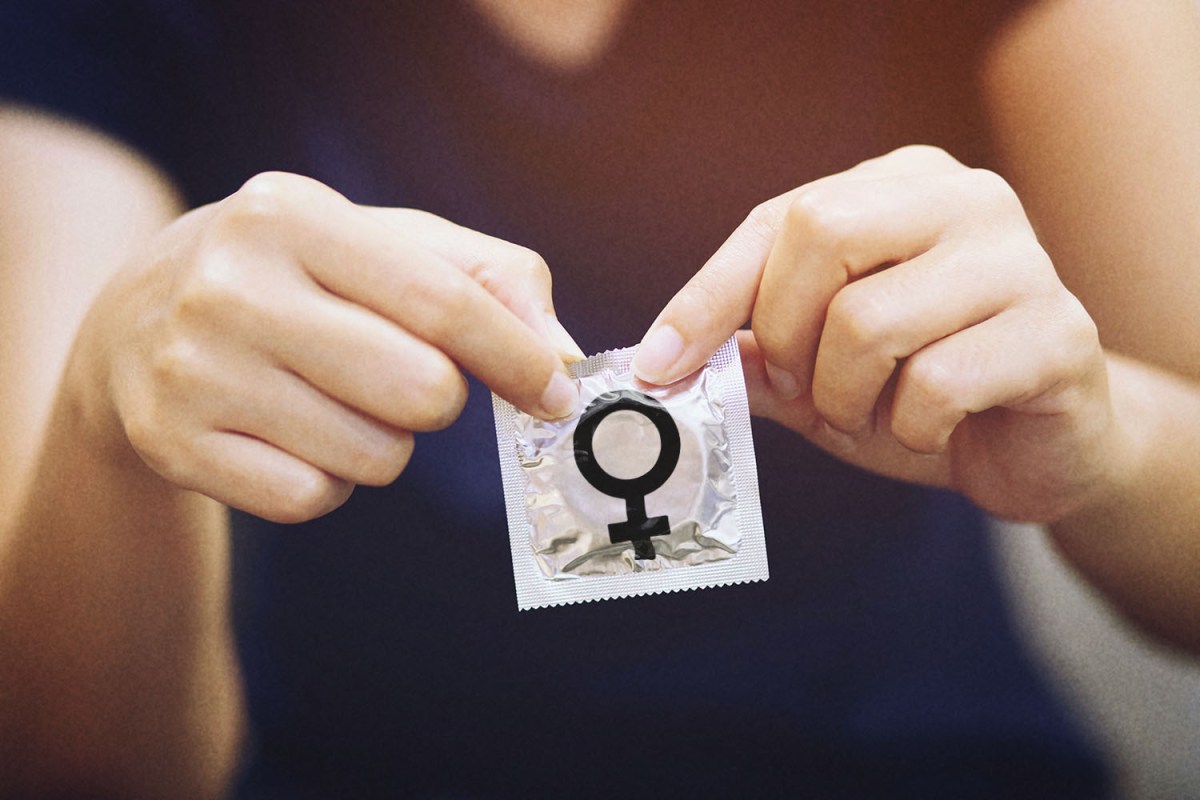Though they’ve been around for about 30 years, almost no one uses internal condoms. According to a recent study, they make up just 1.6 percent of the global condom supply. Even that pittance isn’t uniformly distributed across the world. In a few nations, like Zimbabwe, they’re relatively well known thanks to years of aggressive marketing and distribution efforts. Meanwhile in America, they’re not only off most people’s contraceptive radar, you can’t even find so much as one box of them for sale alongside the vast expanses of external condom brands on pharmacy shelves.
This obscurity is a shame because, contrary to their often unflattering depictions in pop culture, internal condoms actually have a lot going for them. Sure, they may be tricky to use at first, but it doesn’t take all that long to get used to them. Once you do, they offer unique forms of protection against unwanted pregnancies and STIs. For some users, they may be more comfortable or practical than an external condom. Many users even claim that they can enhance sexual pleasure —a sentiment you rarely hear about any type of condom.
There’s so much to recommend internal condoms that it’s well worth the effort of tracking down and shelling out for a pack of them, even in the United States. Men especially ought to consider giving these condoms a shot — even though they were historically marketed as “female condoms.”
No, they’re not just for women
Even internal condoms’ biggest boosters will admit up front that they aren’t as intuitive or easy to use as the ubiquitous external condom. Sure, it’s clear that a receptive partner is meant to put the closed end of the condom inside of their vagina or anus. The small ring at the closed end of the sheath will hold it in place internally, while the larger ring at the open end remains out of the orifice, acting as an external anchor. (Some people remove the inner ring when using internal condoms for anal sex; there’s no standard recommendation on whether that’s the right call.)
But as sex educator and major proponent of internal condoms Eric Garrison notes, it’s easy to get an internal condom twisted up inside of yourself or someone you’re inserting it into. Or for a ring to slip, which may, in the worst case scenario, lead “the penetrator to accidentally bareback their partner.” Some users also report discomfort when inserting, or while wearing, internal condoms. Or that they move around too much during penetration, which can make strange, potentially off-putting plastic bag-like sounds. If you’re not careful when removing an internal condom, there’s always a risk that you’ll end up spilling any fluids collected inside of it, which is obviously not ideal.
But Garrison and other sexperts believe most discomfort and malfunctions are a byproduct of unfamiliarity, which anyone can resolve with a little practice. Most sexual health experts suggest that everyone practice inserting internal condoms a few times on their own before putting them to hardcore use. The CDC even has a great illustrated, step-by-step guide and list of helpful tips for people to follow as they familiarize themselves with this new prophylactic option. Educators also stress the importance of remembering to hold the external ring in place at the moment of penetration to avoid slippage, and of twisting the condom to close off its end and angling it up and away while removing it to avoid spillage. Soon enough, all of these steps and considerations will become second-nature, and most people will find internal condoms secure and comfortable.
Although internal condoms come pre-lubricated, their proponents often recommend adding extra lube to whatever cavity you’re about to insert one into. That should eliminate any lingering sense of discomfort for most users — and improve the condom’s adherence to the walls of the vagina or rectum, cutting down on any weird sounds as well. However, some people may never feel fully comfortable while wearing an internal condom. Sometimes that’s just a reflection of particularly deep-seated anxieties or stigmas about internal condom usage; sometimes it’s down to unique anatomical differences or sensitivities. Whatever the case may be, it’s up to every individual to determine, either on their own or with the aid of a trained medical expert, whether the level of residual discomfort they may feel is something they can ride through in order to harness the benefits of internal condoms.
They can be a better fit — for everyone involved
One of the key selling points of internal condoms for those who master or embrace them is the fact that a receptive partner can insert them up to eight hours before they have sex. When they first hit the market in the late ’80s in Europe and the early ’90s in America, manufacturers and health experts alike pointed out that this would give receptive partners greater power over their own sexual safety. They wouldn’t have to rely on, or convince, a penetrating partner to use a condom; they could protect themselves. This is a big part of why the United Nations actually considers them one of 13 vital yet overlooked health commodities that could save millions of women’s lives every year. But even people who fully trust their penetrating partners to reliably use condoms may still appreciate the preemptive insertion, as it can allow for more sexual spontaneity. They don’t need to worry about being near a supply of external condoms when they start getting worked up, nor do they need to break the flow of sex to break open and apply a condom — which can be a serious mood killer for some people.
Of course, you don’t have to insert an internal condom way before sex. Some people work the process of inserting one into foreplay — although a few experts believe that insertion gets a bit harder when you’re already aroused, as pelvic muscles get tensed and start to contract. (It’s also not a great idea for people with vaginas to keep them in longer than the recommended eight hours, because prolonged usage can increase the risk of contracting a UTI.)
No matter when you insert an internal condom, advocates point out that they will likely provide greater protection from a few types of STIs than external condoms. Herpes, for example, can shed from tissue that isn’t covered by an external condom, like the very base of the shaft of the penis, onto an exposed vulva or anus, leading to a real risk of transmissions even during safe sex. The external overhang of an internal condom doesn’t offer complete protection, but it does put a little more buffer between a person’s vulva or anus and anything traveling on a partner’s penis.
Official public health statistics suggest that internal condoms are a bit less effective at preventing unwanted pregnancies or STIs than external condoms, thanks to the risk of breaks and slippage during active use. But hardcore advocates believe that this just reflects people’s unfamiliarity with the alternative option and that with widespread public education and personal practice this gap may close. Meanwhile, even if they’re not perfect, internal condoms may be better than external ones for some people.
Notably, external condoms are made to fit securely on a fully erect penis. But many people with penises have some level of erectile dysfunction, which makes it hard for them to get or stay fully hard. That may lead to more slippage when they use an external condom, and thus a greater risk of failure. Internal condoms, meanwhile, will offer consistent protection no matter how hard a penetrating partner is at any point during sex, so they’re ideal for guys with ED.
What’s more, Julia Bennett of Planned Parenthood tells InsideHook, people with penises often struggle to find an external condom that fits their particular length and girth just right. When a condom is too loose, it can get all crinkly, or easily slip off. When it’s too tight, it can feel very restrictive, even uncomfortable. But internal condoms are truly one-size-fits-all devices. So, using them allows folks to sidestep the discomfort that leads many people to avoid condoms.
Internal condoms are also made of nitrile, a hypoallergenic synthetic latex, making them a good choice (but hardly the only option) for people with latex allergies. Unlike latex, nitril also works with any kind of external lubrication you might want to use. And many people who engage in frequent receptive anal sex say it’s particularly comfortable for them, because it’s softer than many other condom materials, but still seemingly as resilient to rips or tears as any other.
Nitrile is uniquely good at transferring and storing body heat as well. Partners on both ends of the penetrative equation often tell researchers that, between the softness and the warmth of the material, it feels almost like having sex without a barrier present — which is a major selling point.
Beyond reducing discomfort, Fred Wyand of the American Sexual Health Association told InsideHook that “there’s evidence internal condoms enhance pleasure” during sex as well. Some users say that the internal ring creates a source of stimulation for the head of the penis during penetrative sex, while the external ring rubs against the sensitive anus, or the clitoris. And on a more abstract level, in focus groups receptive partners often tell researchers that just knowing they can insert their own protection before sex — and thus have more control over their health — provides a degree of comfort that enhances their ability to experience pleasure during sex.
The vilification of internal condoms
So why aren’t internal condoms far more common, if they have all of this going for them?
The answer to that question is complex and multi-faceted. But at its heart, it arguably boils down to the fact that they unfairly got a bad rap when they first came out in the United States. The press tore into them, with writers arguing that they looked gross, comparing them to ostomy bags or jellyfish. Reporters also focused on the ways they were inferior to external condoms, while ignoring how those shortcomings might be mitigated, and downplaying their unique upsides.
Several experts InsideHook spoke to for this story speculated that this heavy criticism was in part a reaction to the fact that internal condoms were initially approved by the FDA, and marketed, as a woman’s product. Female condoms were cast as inherently worse than the old male condoms. This bias wasn’t always subtle; some papers openly accused the FDA of compromising its legitimacy by approving a definitively inferior product supposedly to appease radical feminists.
The design and efficacy of internal condoms has improved with time. In 2018, after years of lobbying, the FDA changed their official name from female condoms to the more inclusive and accurate internal condoms, officially allowing companies to market them to more than just women. (Before 2018 any other recommended or practical use of these products was, officially speaking, “off-label.”) And it’d be nice to believe that at least some of the inherent, systemic misogyny reflected in the extreme reactions to internal condoms when they first came out has dissipated over the years.
But the cultural damage of those early years is deeply ingrained now. As recently as the 2010s, even ostensibly feminist publications in the United States had a habit of offhandedly dismissing internal condoms as inherently gross, as a failed option, relegated to obscurity by the market.
“Sometimes, I wonder how many people would be using internal condoms today if they weren’t viewed as a ‘female’ product,” mused Patricia Coffey, a leading expert on internal condoms.
On top of bias, the novelty of internal condoms led the FDA to impose stricter regulations on internal condoms than external condoms, which the agency also only lifted in 2018. The details get a bit arcane and convoluted, but basically they were put into the same regulatory category as medical devices like pacemakers. Narrow profit margins and ongoing stigmas against funding research and development of sexual products mean that it’s already hard enough to develop new external condoms. These added barriers made it next to impossible to shake up the internal condom space, which is a big part of why the United States has over 300 different types of external condoms available for sale, but only one brand of internal condom made by one firm — despite the availability of more, and more diverse, internal condom designs in other nations.
Pervasive stigmas, low innovation and an utter lack of competition meant that internal condoms never got the level of state or corporate support that helped the external condom gain mainstream respectability and visibility during the late 20th century, Erica Campos, a sex educator who works with the condom megastore Condomania, tells InsideHook. Even sex educators “did a poor job in terms of getting the word out about them,” she adds. This marginalization didn’t just make internal condoms conceptually obscure; it made them exceptionally expensive. Thanks to years of production experience, as well as scales of manufacturing and demand, the average external condom costs about half a buck a pop, and as low as $0.02 a piece in a bulk order made by a big public health agency. Internal condoms, meanwhile, cost at least $2 a piece, and over fifty cents each in bulk. Some insurance plans cover these costs, Campos notes — if you’re willing to jump through all of the hoops that often come with asking American insurers for … well, anything.
Marginalization also has a nasty habit of reinforcing itself in a market system. Case-in-point: In 2017, Veru, the company that makes the FC2, the only internal condom available in the United States, determined that off-the-shelf sales of their product were so poor that it didn’t make logistical sense to keep supplying them to retail pharmacies. So, they pulled them from aisles across the nation. Now you can only get internal condoms at pharmacies if you come in with a prescription for them — or if a health clinic in your area has opted to keep a free supply flowing.
Even if an individual can look past the stigma that still unfairly swirls around internal condoms in the United States, these price and accessibility issues are major barriers to experimentation, and potentially popular embrace. But they’re not insurmountable. The CDC actually has a quick-and-easy tool that’ll help you find internal condoms, including free samples, in your area. A rep from Veru tells InsideHook that they have several programs to help people access their product, no matter where they are or what their resource situation is like, which you can find on their site.
It’s worth taking the time and effort to make use of these tools, because if we as consumers show enough interest in the potential of internal condoms, then, bit by bit, sex educators, public health NGOs and the eldritch beast that is the market will respond. They’ll pour more time, effort and cash into probing and trying to expand that demand. Maybe new players in the sexual health space will even see enough potential to justify not just investments in better consumer education and distribution, but in innovation, change and healthy competition. The easier it gets to find internal condoms, the easier it’ll get for people to just try them out on a whim, potentially fueling new sustained demand. And so a virtuous cycle may be created.
On a much smaller and more personal level as well, Planned Parenthood’s Bennett argues, it’s worth extending a little effort to try out internal condoms. “You never know,” she said. No matter who you are, “you or your partner, or partners, might prefer the feel” in the end.
The Charge will help you move better, think clearer and stay in the game longer. Subscribe to our wellness newsletter today.
























